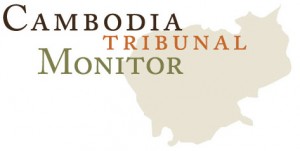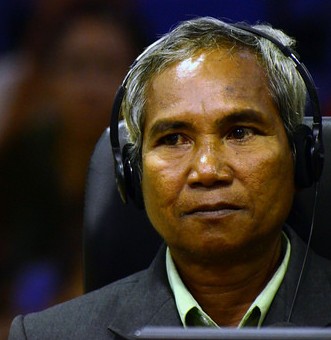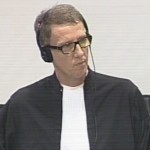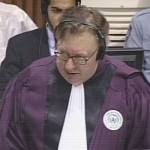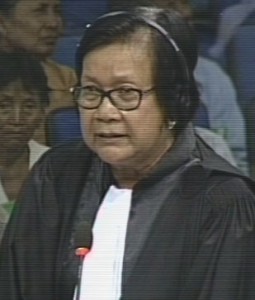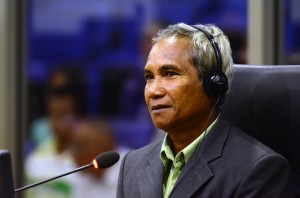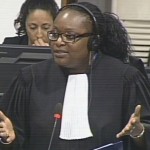“If Anyone Saw Me Weeping, I Would Be Accused Of Not Being ‘Absolute’ And Killed” – Witness On Trapeang Thma Dam Worksite
Today, on August 12, 2015, The Trial Chamber continued hearing witness Mr. LAT Suoy on the Trapeang Thma Dam (TT Dam).
The hearing started by clarifying references to documents that were mentioned yesterday both by the defense and the prosecution.
The prosecution then finishes its examination of Mr. Suoy. Mr. Dale Lysak starts by asking how the living conditions changed after the arrival of cadres from the SW Zone.
Mr. Suoy says that the SW zone cadres limited the food ration to 100 cans of rice for 100 people per day. Suoy also said the work at night got harder.
“People who were starving and stole a potato would be severely mistreated. It was the opposite of the NW cadres,” Suoy added.
Mr. Suoy recalls that Ta Nhim told his subordinates to be careful so that they would not be arrested. Suoy was not present at that meeting though. He says he was told by his chief that this had happened.
Lysak moves on to ask him, based on his DC-CAM interview (which is available in full here!), something that he presumes the defense will ask him in depth about. Lysak reads from his DC-Cam statement:
“Suoy: Ta Nakk held a military meeting with chiefs of district and commanders.
Dara: Oh.
Suoy: He told the troops and informed the Northwest Zone to get ready.
Dara: Oh.
Suoy: In order to defeat the Southwest, [we] got ready by transporting the weapons to the forest. And after being called to return, [we] were arrested easily at home. That was done by Ta Mok.”
When Lysak attempts to ask the following question, Koppe strongly objects: “Was this [storing weapons] a secret plan by Ruos Nhim to rebel against Pol Pot or was it an effort from the NW Zone to defend themselves against the SW zone who had come to kill you?”
Koppe objects with the memorable line: “If we do not have a textbook definition of a leading questions there you have it.”
Lysak responds that it is not a leading question as it is giving the witness a choice. He further adds that Koppe has led every single witness with the assumption that there is a plot to overthrow Pol Pot.
The chamber overrules the objection. Mr. Lysak asks the same question again and Mr. Suoy, the witness, confirms that it was a plan from the NW zone to defend themselves against the SW zone.
Mr. Suoy says that he knew that currency was printed in Phnom Penh and that it was ‘redish’ with some people farming in the field in the background.
Then Lysak asks how he knew that Ta Nak wrote letters to Ta Val as he had testified in his DC-Cam Statement, available above. Suoy does not clarify but gives detail about how they worked together.
Lysak finishes his examination by asking why he was sad when he visited the TT Dam, only once about twenty years ago.
“When I returned to to the TT Dam, I was sad because I recalled how we had worked there days and nights and we were only given ½ a can of rice per day,” Mr. Suoy said.
__
Ms. CHET Vanly, Civil Party Co-Lawyer, then took the floor.
To Chet Vanly he says that he was at the TT Dam twice. First he went as part of the army when he was deployed to guard the dam. Secondly, he says he was assigned to carry human excrement to be used as fertilizer after the SW Zone cadres had arrived and he had “turned civilian.”
Mr. Suoy insists that the Dam started to be built in late 1976.
Suoy does not know who took over after Ta Val was arrested.
Suoy says that they were told that Angka would visit the TT Dam but they were told not to look at them. Suoy says he glanced at them and they were wearing white short-sleeved shirts but he does not know who they were.
Suoy said that many workers died at the Dam from malaria, from carrying too much earth and because of “swollen body, they could not walk,” he said.
Suoy said that the quotas were not by individual but by group. “If any unit failed to meet the quota, then Angka would take them for education. And they actually considered us as having betrayed Angkar,” he said. “it means they would be taken for execution, they would be shot to death.”
“Did workers ever complain at all” Ms. Vanly asked.
“At the time not one dared complain about the lack of food. When they were given only a ladle of gruel, workers were asked if they were full and workers said they were,” he explained.
Ms. Vanly asked if there were pregnant women at the worksite Mr. Suoy responded:
“We were forbidden from loving each other. If anyone was found loving each other they would be taken away for execution.”
Ms. Guiraud, international civil party lawyer, then took the floor.
To Ms. Guiraud he confirms that he was carrying weapons when he was guarding the dam. He said he carried a rifle. He also said that every member of his ten-person unit had a rifle. He said he never used it as he did not know how to use it. “I only carried the rifle slung across my shoulder.”
Ms. Guiraud recalls that Mr. Suoy had testified that he had wept a lot when he was taken into the jungle when he was around 15-years-old. Mr. Suoy responded: “I did not allow anyone to see me weeping because if anyone saw me, I would be accused of not being absolute and killed.”
“We were considered absolute and we had to forfeit all our personal possessions and belongings,” he added.
—
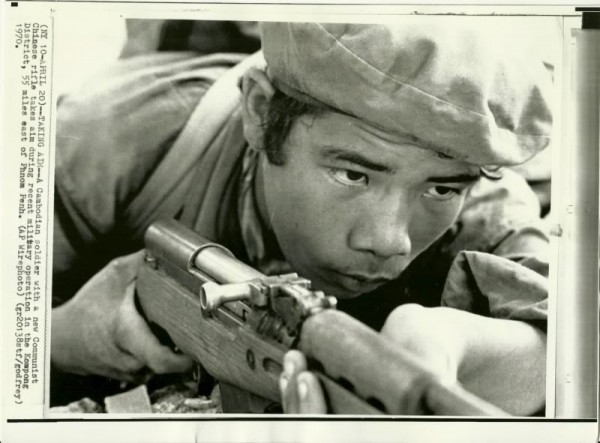
A picture, found on this blog, with a caption from the AP that claims to be of a Cambodian soldier with a “communist rifle” in 1970. This rifle seems to be the same CKC (or SKS) rifle, of which the witness spoke about.
To Judge Lavergne, Suoy confirms that his rifle was a CKC rifle that could only be shot once, but each magazine had 10 bullets. Suoy remembers he was told it was made in China.
Mr. Suoys says that he did not understand what an ‘absolute’ meant. Later, he still did not understand what it meant.
Suoy confirms to Judge Lavergne that those who were educated, like teachers were killed.” Once they found out we were educated, they would be executed,” he added, “those that were educated had to pretend to be illiterate. I pretended not to know how to read and write.”
He confirms that he had heard of bamboo traps which were sent to the border with Thailand. He told the Bench that women sharpened the bamboo sticks and then these were sent to the frontline.
To Judge Lavergne, he now says that he never saw the pits where people who alleged they had night blindness were made to walk next to. He says that someone told him about two people who had been tested like this. One of them fell in and the other one did not. The one who did not, was sent to be re-educated.
Suoy clarifies that he saw the currency he had mentioned before, about two months before the Vietnamese arrived. He says it was for their salaries. He then says that the money was issued by the SW zone cadres in the NW zone but does not know where it actually came from.
—
Victor Koppe, lawyer for Nuon Chea, starts the cross-examination.
A fortnight after Ta Val was arrested, Suoy says, the SW zone cadres asked him and his colleagues to lay down their weapons. And then they were reassigned to work in a mobile unit picking up cow-dung.
Suoy seemed to testify that he arrived at the Dam before thousands of workers arrived. He does not know what the date was.
Koppe attempts to ask whether just a platoon of thirty men could guard the 15,000 workers. Mr. Suoy does not confirm or deny this but explains that workers did not flee because they were not familiar with the territory and it was surrounded by jungles.
Ta Val
Suoy confirms that from 1975 until the regime fell, Ta Val was in charge over the zone. He confirms that he called the TT Dam, the Ta Val Dam. “People in Sector 5, called it Ta Val’s Dam,” he added.
Suoy confirms that Ta Val was a very mean man. “His words were very mean and not one dared to look at his face,” he continued “If he found someone committed an offense he would send that person to be executed and that is why people feared him.”
Suoy does not know whether Ta Val was an intellectual, a former teacher, or what his level of education was. He never saw him write anything or ever heard him speak French “At the time no one was allowed to speak a foreign language,” Suoy said, “no matter how high you were. People had to pretend that they did not speak any other language.”
After reading a lengthy reading of an excerpt from Koppe that testified that Ta Val and Heng were educated and spoke French, Koppe attempts to ask if that now changes his position. Lysak, the prosecutor, only has to rise for Koppe to withdraw the question and rephrase to ask Suoy to comment. Suoy says that he cannont comment on their education level.
Koppe then reads an excerpt that testified that Suoy Ta Val, Heng,, and Mong stayed together and had known each other since the army days. Suoy explains that he knew them but that he did not stay together with them.
Koppe asks why he was happy that Ta Val, in Koppe’s words, a vicious mean killer was arrested. Suoy explained they were not relieved because in the military, if the senior leaders were arrested all the inferiors would be arrested and executed.
Lysak objected to the question on the grounds that the whole assumption of the question is flawed as it is presupposing that Ta Val was arrested because of what he did at TT Dam and not for carrying out the party’s policy. Lysak also says that Koppe is arguing with the witness.
Suoy maintains that he was frightened of being arrested and killed.
Koppe then asks Suoy if he himself was a vicious killer. The prosecutor objects on the grounds that it is based on a ridiculous premise that Pol Pot and Nuon Chea were arresting Ta Val because he was a vicious killer. The court sustains the objection.
Hidden weapons
Suoy seems to say that the cadres from the NW Zone did not know that the SW zone cadres would be coming and thus, according to Koppe, the prosecution’s point that the weapons were there to protect themselves from the SW Zone would not hold up. The questions is put to Suoy, but we receive no translation and Koppe moves on.
Currency
Koppe points out the inconsistency, according to him, that Suoy had said that Ta Nhim issued the currency but Nhim was arrested in mid-1978 and could not have issued it two months before the Vietnamese arrived in January 7. In his testimony yesterday, Suoy had said that it was the SW zone cadres that had issued it.
Lysak asks for a clarification as ‘printing’ and ‘giving currency’ to soldiers are two different things covered by the phrase ‘issuing currency’. Koppe agrees.
Suoy says that he saw the money in late 1977 but does not know who printed.
Koppe reads from Suoy’s DC-Cam statement:
“Suoy: Ta Nhim did not know about it. He planned to reform society.
Dara: Oh.
Suoy: [He planned] to get people to do business, and that’s why the currency
was printed.
Dara: Oh.
Suoy: [He was] printing the money so that people could buy products from
the cooperatives.”
Suoy said that Nhim had said that business would be restarted and salaries would receive a salary. But then he clarifies that he did not hear it himself but other people told him.
Koppe reads a long excerpt from his DC-CAM statement before he asks permission from the Chamber to show a color copy of different currencies from before DK and during. The Prosecution objects as it is not clear that they are legitimate representations and would like to seem them before they are used with witness. Judge Lavergne asks why Koppe did not prepare the Chamber for this. Koppe explains that he put the black and white notes on the interface. Lavergne cuts him off to ask about the color copies. Koppe admits that they are not in the case file and so cannot be technically put on the interface.
Koppe says that he is doing the same thing as Judge Lavergne in case 002/01 when he downloaded pictures from the internet. Lavergne explains that in the future he should respect the rules.
Traitorous NW Zone?
Suoy says that they accused the whole NW Zone as traitors and says that at that point he did not know what they meant with the words traitors.
Koppe then reads from the DC-CAM statement:
“Suoy: the Eastern Zone was about to flee to the forest in order to join forces with the Northwest.
Dara: Oh.
Suoy: The friendship between these two Zones was meant to crush the Southwest to extinction in order to reestablish the revolution. That included conducting business amongst cooperatives.”
Koppe then asks if that had something to do with the treason. Lysak objects on the grounds that Koppe is fishing and putting words in the mouth of the witness. Koppe says “then I’m in good company,” and rephrases to ask whether the SW Zone cadres accused the NW Zone cadres because they wanted to take over the revolution. Suoy only says that he heard that the SW Zone cadres accused the NW zone of traitors and then two months after they arrived.
Flirty?
Koppe moves to ask him if he liked, as a man, women from the SW zone. Suoy says he never liked them.
Koppe then reads from a statement that says that Suoy was “very flirty. I was single and I was talkative and at that time it meant many wives.” Suoy remembers a few of their names.
The President asks Koppe to rephrase as these questions are not relevant. Mr. Koppe apologizes and says he will leave “flirty” out of it. Suoy does not remember talking with his “wives” about why the SW zone called the NW zone traitorous.
Back to currency
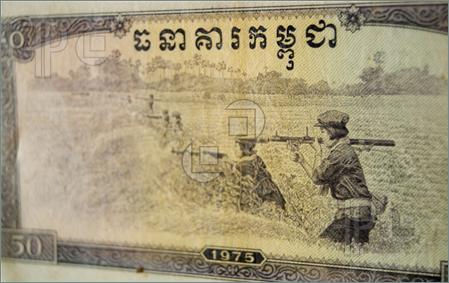
This page claims that this is a banknote from the Khmer Rouge era. It is not clear whether this one or a similar one was the one shown in court.
After the afternoon break, Koppe, with no objection from the prosecution, shows Mr. Suoy the colored banknotes that Koppe had referenced before.
Suoy only repeats that what he had seen in 1977 or 1978 was a 10 riel note with two people on the side carrying a hoe. Koppe directs his attention to one of the notes and asks Suoy if it resembles the one he had seen at that time. He says the difference is that there are several persons appearing while the one he saw back then there was only one or two persons.
Suoy clarifies that the one he saw is similar to one of them but the difference, he repeats, is that more people appear in the one he remembers.
The prosecutor rises to say that this exercise has reached the limit of its usefulness as saying that the notes are familiar to him does not tell us anything. And that the only way to move forward would be to put to him all the notes that the DK regime put out.
The Bench overrules the prosecution’s objection.
Suoy is not familiar with the first or the second note on the page.
—
After a few questions about Suoy’s wife, Koppe rests and the floor is given to Ms. Anta Guissé, counsel for Khieu Samphan.
Suoy explains that he was not trained to use the rifle but that he asked his colleagues how to use it. He said he never used the weapon. “Only after joining the ‘absolute’ unit did I get to know the weapon.”
Suoy says he always ate with his comrades and that, Guissé implies, would mean that he did not know what the rations were for the workers.
Suoy says he was not in charge of any unit. Guissé reads a statement from a future witness that testified that LAT Suoy was the head of a small unit
Suoy responds: “I swear if front of this Court that I was not in charge of any unit. If I am not telling the truth, may god punish me.”
Guissé responds that she “is not asking for so much.”
Suoy does not know who this person who testified that he was the head of a small unit is.
The Court adjourns and the cross-examination of Mr. Suoy will finish tomorrow starting at 9 a.m.
